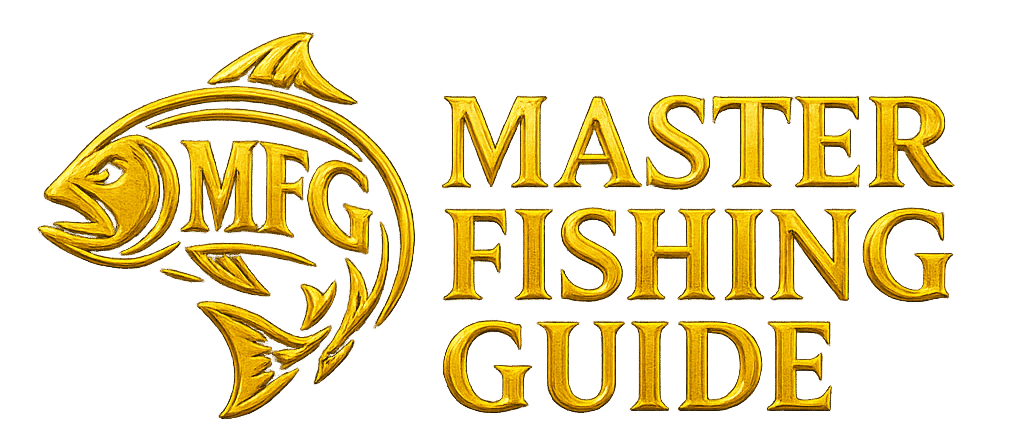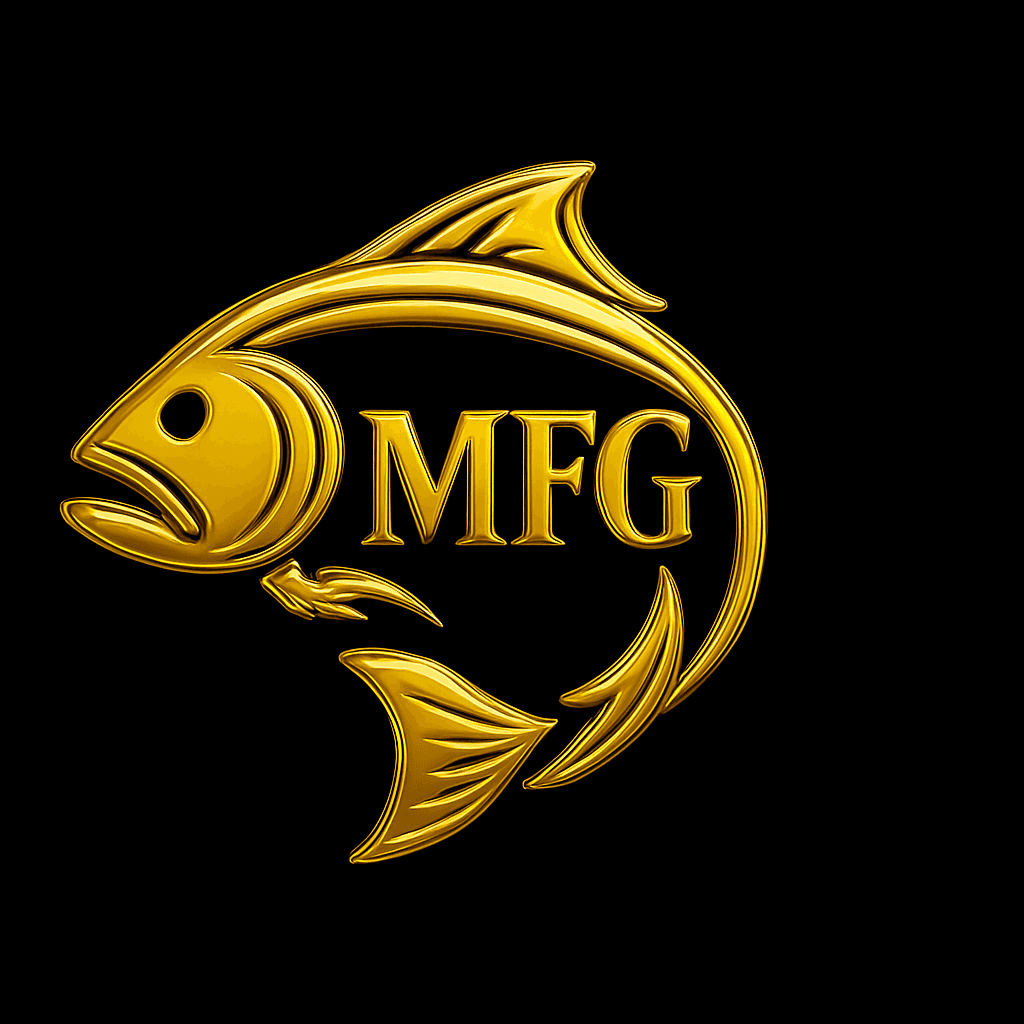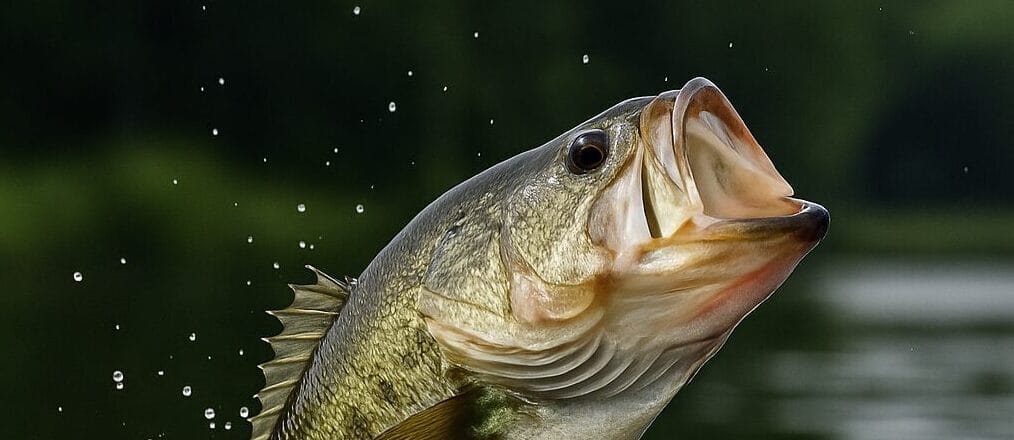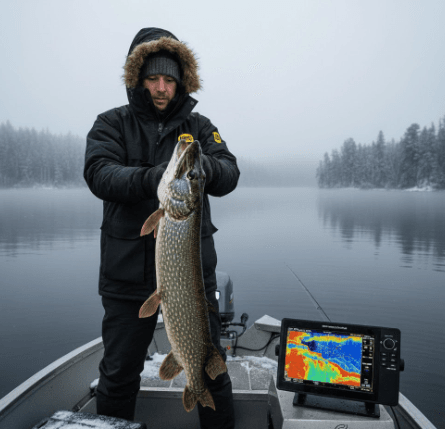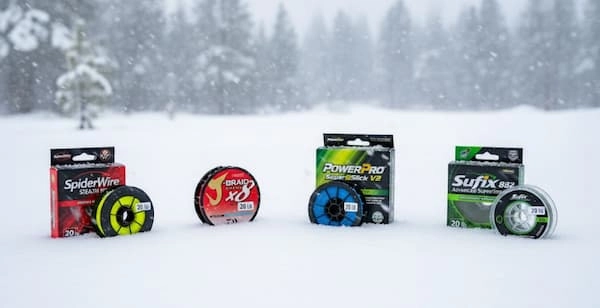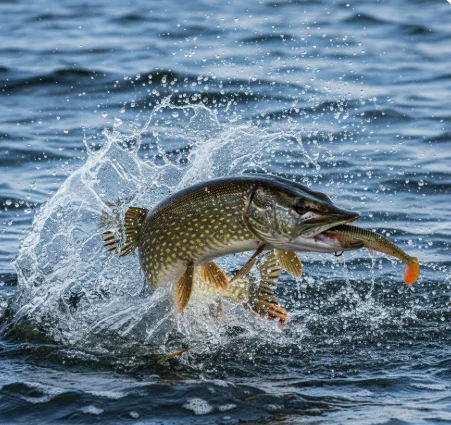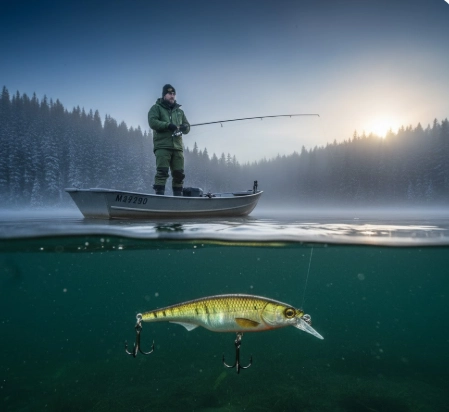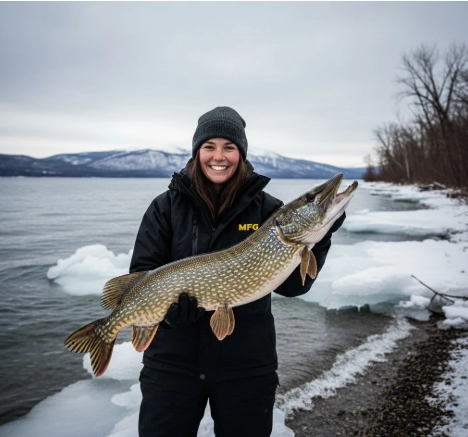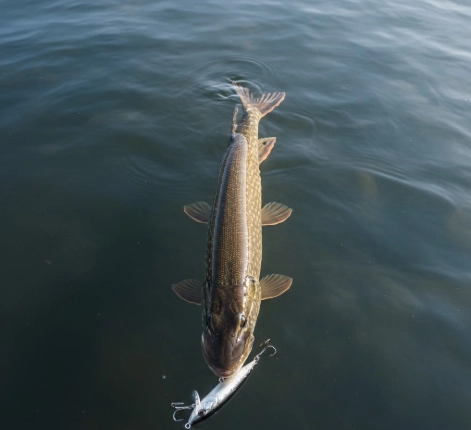Best Bass Fishing Guide 2025 – Tips, Lures, Rods & Rules for Beginners and Pro
As an Amazon Associate, we earn from qualifying purchases — no cost to you. That’s how we keep this site running. Read more ›
Bass fishing isn’t just another way to spend a weekend on the water – it’s the most popular form of freshwater angling, and for good reason. Millions of anglers head out every season in search of largemouth, smallmouth, and spotted bass. For some it’s a casual pastime, for others it’s a serious pursuit with tournaments, rivalries, and big paydays on the line. From small farm ponds to massive lakes, bass are everywhere, and they’ve become the fish that defines modern sportfishing.
What makes bass so special is the perfect mix of qualities they bring to the table. They’re aggressive feeders with explosive strikes, strong fighters that test your gear, and versatile enough to be caught on just about every lure imaginable. They’re abundant, which means beginners can find them close to home, and they’re unpredictable, which keeps even the most experienced anglers challenged. Every bite feels different, every season brings new patterns, and every cast holds the potential for that unforgettable strike that gets your heart racing.
The entire fishing industry has been shaped by this species. Walk into any tackle shop and the evidence is everywhere: aisles filled with crankbaits, spinnerbaits, jigs, worms, and frogs, all designed with bass in mind. Rods and reels are fine-tuned specifically for the demands of bass fishing, and entire boat designs were created to give anglers an edge. Electronics like sonar and GPS mapping continue to evolve because bass anglers push the limits of what’s possible. This fish has not only captured the imagination of millions of anglers – it has driven the innovation of modern fishing itself.
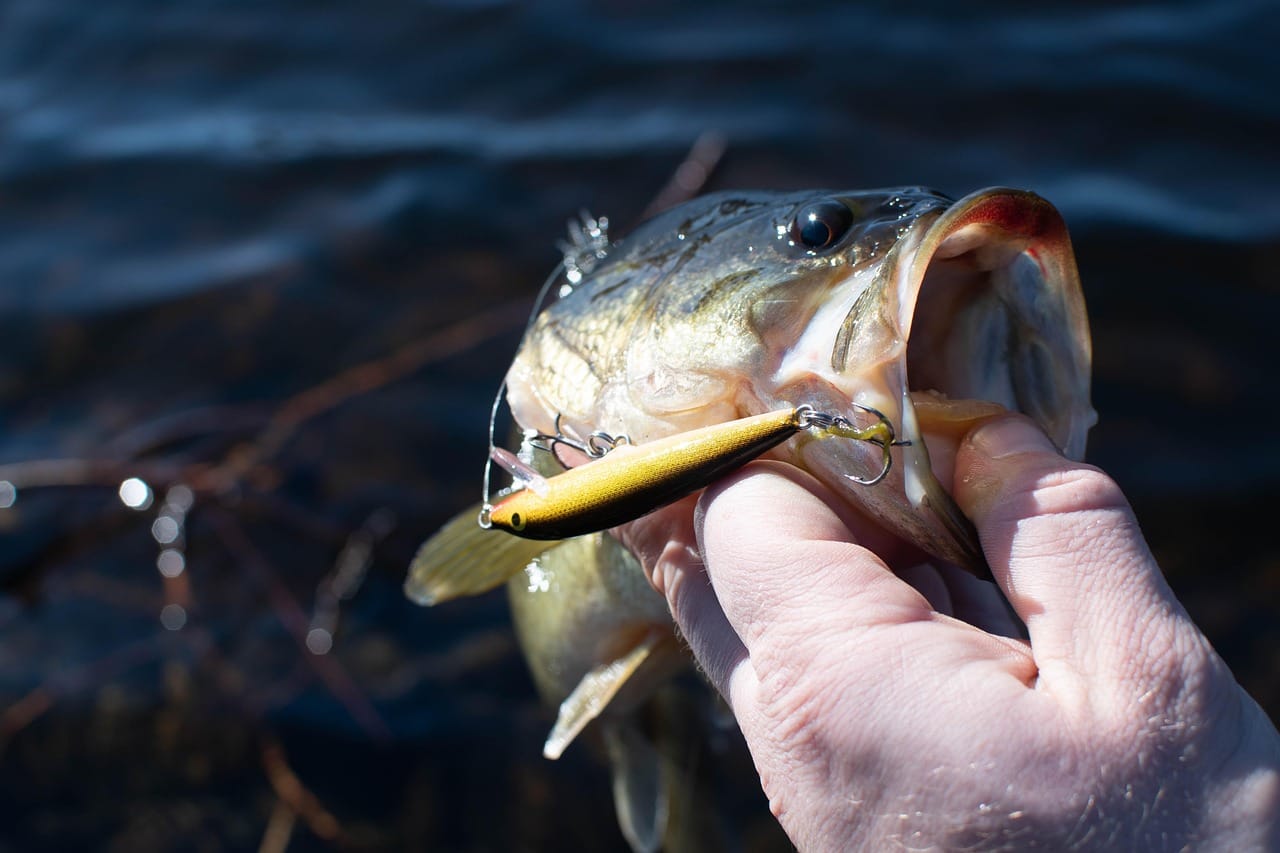
The best part is how easy it is to get started. You don’t need a $60,000 bass boat or a wall of rods to enjoy the sport. A simple spinning combo, a handful of lures, and a local pond are all it takes to start catching fish. At the same time, bass fishing is deep enough to keep you learning for a lifetime. Techniques like flipping heavy cover, finesse fishing with soft plastics, or working a topwater bait at dawn can take years to master. That balance – easy to enter, impossible to completely master – is what keeps people coming back season after season.
Bass fishing is also about the moments. The first blowup on a topwater lure, the thump of a jig on the fall, or the sudden stop of a crankbait when a fish crushes it – those memories stick forever. Ask any angler and they can tell you exactly where they were and what they were throwing when they caught a personal best. It’s not just about numbers or trophies; it’s about the rush, the story, and the connection to the water that keeps us hooked. Once you experience that, you understand why bass fishing isn’t just another hobby – it’s part of who we are.
This guide is built to give you the complete picture of bass fishing in 2025. We’ll look at the different types of bass, their seasonal behaviors, the techniques that consistently put fish in the boat, and the gear that makes the job easier. Along the way you’ll get clear, practical tips that can help you fish smarter and catch more. Whether you’re picking up a rod for the first time or chasing double-digit giants, the goal here is to lay down a foundation that makes every trip to the water more productive and more fun.
So let’s get into it. Grab your rod, tie on your favorite lure, and dive into the world of bass fishing. This isn’t just another article – it’s a roadmap for making the most out of every cast, every fight, and every memory that comes with chasing the most popular fish in freshwater.
Types of Bass
Largemouth Bass
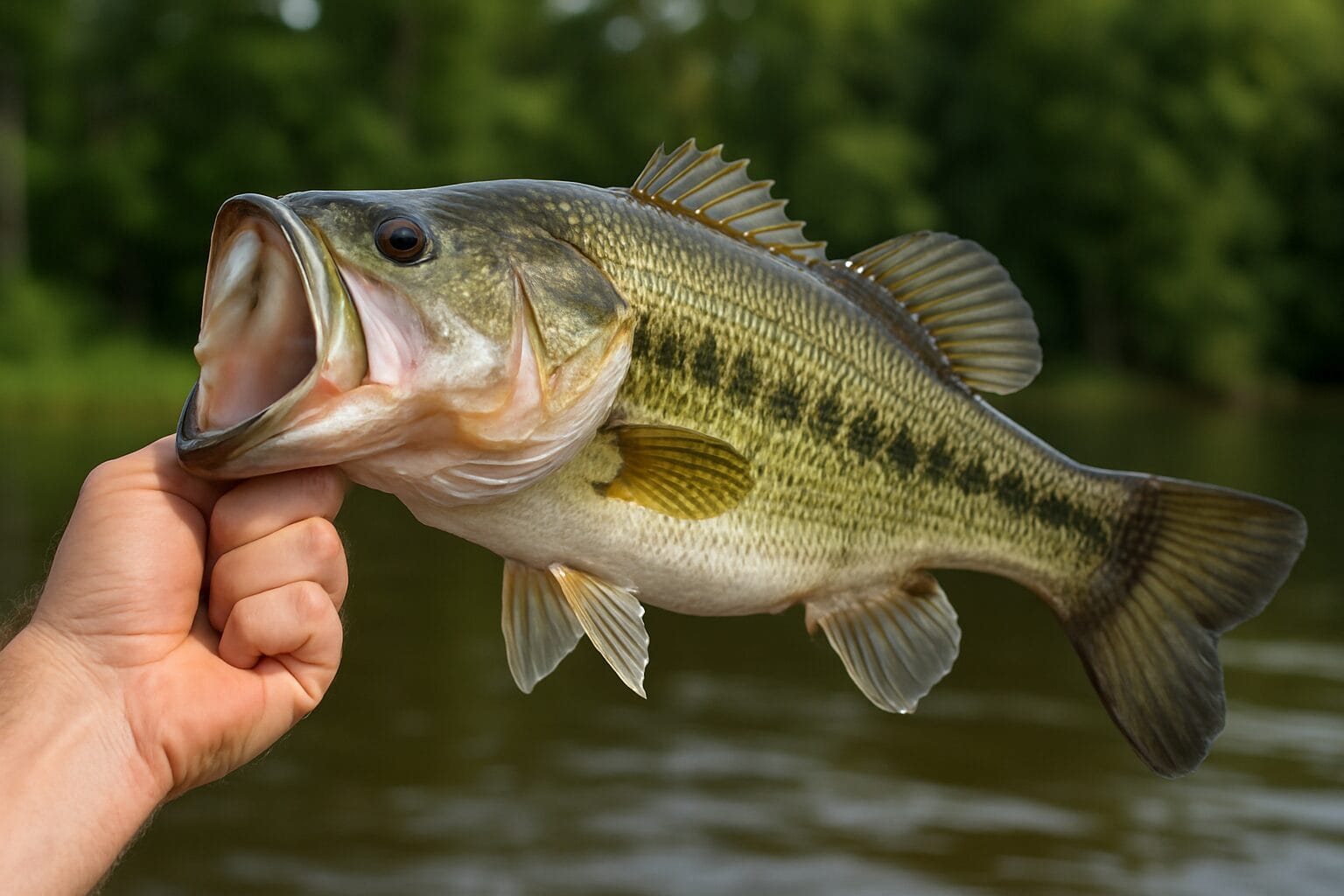
The largemouth bass is the most iconic freshwater gamefish and the species that defines the sport. Known for its oversized mouth, aggressive strikes, and ability to grow to trophy size, the largemouth is often the first fish that comes to mind when people think about bass fishing. They thrive in warm, shallow waters with plenty of cover like weeds, fallen timber, and docks. Because they’re opportunistic feeders, largemouth can be caught on everything from plastic worms to topwater frogs.
Some of the best largemouth destinations include legendary waters like Lake Okeechobee in Florida, Lake Fork in Texas, and Clear Lake in California. These lakes consistently produce trophy-class bass over 10 pounds and attract anglers from all over the country. Other hotspots like Chickamauga Lake in Tennessee and Sam Rayburn Reservoir in Texas have become must-fish locations for serious bass anglers. Whether you’re fishing a farm pond or a massive reservoir, largemouth bass are never far away.
Smallmouth Bass
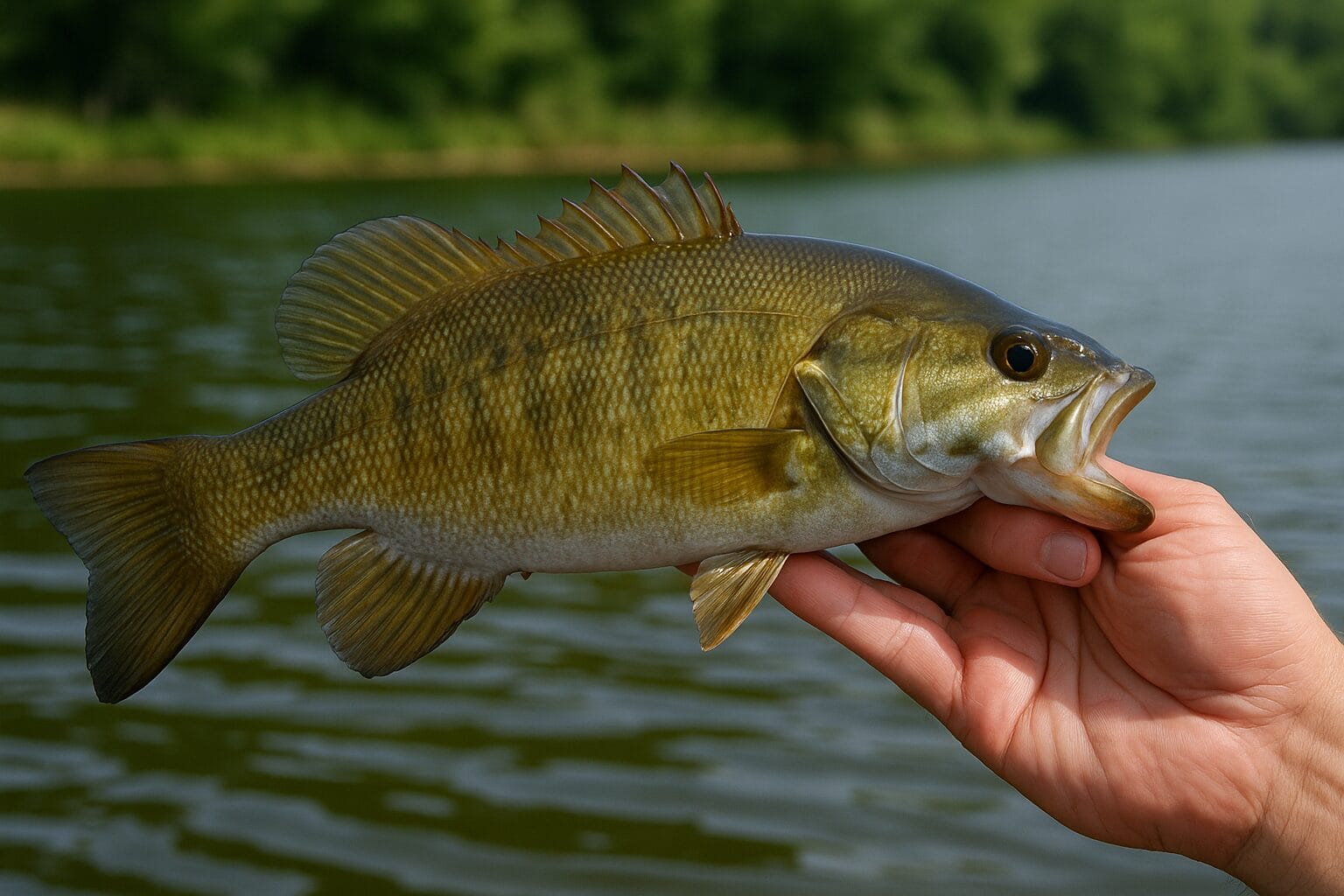
Smallmouth bass may not grow as large as their largemouth cousins, but pound for pound they are considered one of the hardest-fighting freshwater fish. Recognizable by their bronze color and smaller mouth, smallmouth thrive in cooler, clearer waters with rocky bottoms, current, and less vegetation. They are more aggressive in open water and often strike baits with incredible speed, making them a favorite among anglers who love fast action and strong fights.
Prime smallmouth locations include the Great Lakes, particularly Lake Erie, Lake St. Clair, and Lake Ontario, which are famous for producing monster bronzebacks over five pounds. Rivers like the Susquehanna in Pennsylvania and St. Lawrence in New York are also world-class smallmouth fisheries, with strong populations and excellent seasonal runs. Northern lakes in states like Wisconsin and Minnesota consistently offer quality smallmouth action as well, making them a top target for anglers who want power-packed fights on lighter tackle.
Spotted Bass
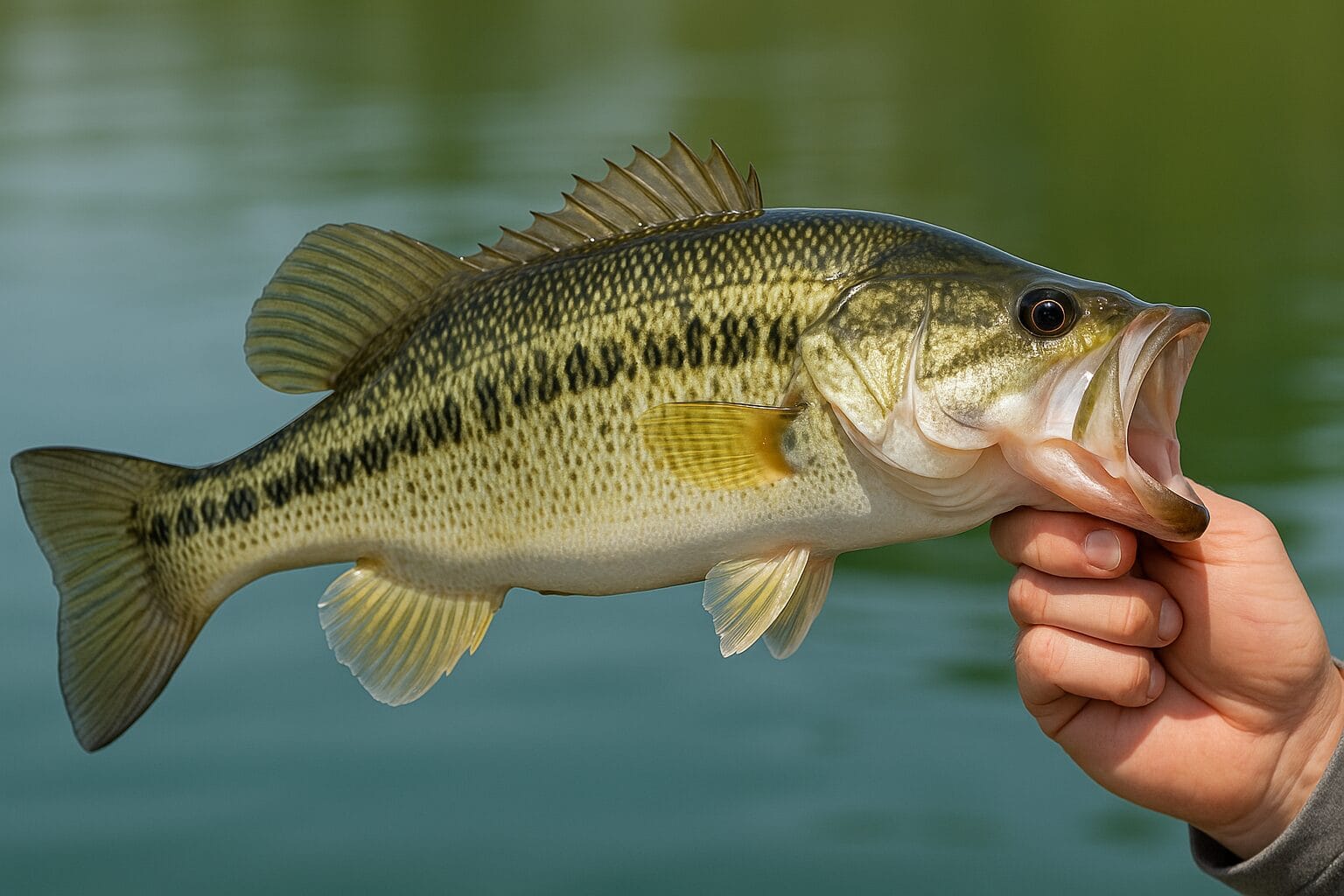
Spotted bass, sometimes called Kentucky bass, are often mistaken for small largemouths but have their own unique traits. They have a slimmer body, a rough tongue patch, and distinct spots along their sides. Spots are more aggressive than largemouth but don’t usually reach the same trophy sizes. They prefer deeper, clearer waters with rocky structure and are known for schooling behavior, which can create fast-paced fishing when you locate a group.
Top waters for spotted bass include Lake Lanier in Georgia, Lake Norman in North Carolina, and Lake Shasta in California. These lakes have built reputations for producing quality spotted bass and hosting major tournaments. Other strong spotted bass fisheries include Lake Cumberland in Kentucky and the Coosa River system in Alabama. While not as widespread as largemouth or smallmouth, spotted bass offer a unique challenge and can provide nonstop action when conditions are right.
Seasonal Bass Fishing Guide – Spring, Summer, Fall & Winter
If you want to consistently catch bass, you need to understand how their movements change with the seasons. Bass follow predictable patterns driven by water temperature, spawning cycles, and food availability. Knowing where bass go in spring, summer, fall, and winter will help you choose the right spots and lures every time you hit the water.
Spring Bass Fishing
In spring, bass move shallow to feed heavily and prepare for the spawn. As water warms into the 55–70°F range, look for largemouth, smallmouth, and spotted bass on staging areas near flats, coves, and protected bays. This is the best time to catch big females before they lay eggs. Jigs, suspending jerkbaits, and soft plastics shine during pre-spawn, while sight-fishing with worms or creature baits is deadly once bass are locked on beds.
Summer Bass Fishing
During summer, bass head deeper to escape the heat and find cooler, oxygen-rich water. Largemouth position on ledges, drop-offs, and heavy vegetation, while smallmouth roam offshore humps, points, and rocky shoals. Early morning and late evening bring explosive action on topwater lures, but once the sun is high you’ll need deep-diving crankbaits, Carolina rigs, or football jigs. Electronics like sonar are crucial for locating summer bass schools offshore.
Fall Bass Fishing
In fall, bass follow baitfish migrations into creeks, coves, and shallow bays. As shad and minnows gather, bass group up and feed aggressively, creating some of the fastest action of the year. Search for surface activity or diving birds – both signal feeding fish. Cover water quickly with spinnerbaits, squarebill crankbaits, and topwater lures to intercept moving schools.
Winter Bass Fishing
Winter is the toughest season for bass anglers, but you can still catch fish if you slow down. Cold water pushes bass into deeper, more stable areas like channels, bluff walls, and submerged timber. They feed less often, but when they strike it’s usually on subtle, slow-moving baits. Jigs, blade baits, and finesse rigs like the drop shot are winter staples. Downsizing your line and lures, plus keeping patience, is the key to success during the cold months.
Best Bass Fishing Techniques for Beginners
Bass can be caught in many ways, but certain techniques stand out because they consistently put fish in the boat. These methods are beginner-friendly, proven over decades, and can be adapted to almost any lake, pond, or river. Mastering these will give you a strong foundation and help you catch bass in all kinds of conditions.
Topwater Bass Fishing
Few things in fishing compare to the explosion of a bass smashing a lure on the surface. Topwater lures like poppers, walking baits, and hollow-body frogs are best used early morning, late evening, or on cloudy days. Work them slowly around cover like lily pads, logs, or grass edges to trigger explosive strikes.
Finesse Bass Fishing
When bass get pressured or conditions are tough, finesse techniques shine. Light line, spinning rods, and subtle presentations fool even the wariest fish. Popular setups include the drop shot rig, Ned rig, and shaky head worms. These techniques are deadly in clear water or during cold fronts when bass are less aggressive.
Flipping and Pitching for Bass
Flipping and pitching are close-range power techniques designed for heavy cover. Using a stout rod, strong line, and a compact bait like a creature bait or jig, you can drop the lure right into thick vegetation, laydowns, or dock pilings. This method produces big bass that hide where most lures can’t reach.
Crankbait Fishing for Bass
Crankbaits are one of the best tools for covering water quickly and finding active fish. Depending on the season, you can use squarebill crankbaits around shallow cover, lipless crankbaits in open flats, or deep-diving crankbaits on ledges and offshore structures. Cranking imitates baitfish and triggers reaction strikes from aggressive bass.
Jig Fishing for Bass
If you want to catch big bass year-round, jigs are hard to beat. A bass jig with a trailer imitates crawfish or bluegill and can be worked around rocks, docks, timber, or grass. Jigs are versatile, producing bites in shallow cover during spring and deep structure in winter. They are a confidence bait for many of the best bass anglers in the world.
What Are the Best Bass Fishing Lures?
Choosing the right lure is one of the most important parts of bass fishing. Different lures work better depending on season, water clarity, and cover. Below are the most effective bass lures of all time, along with tips on when and how to use each one.
Plastic Worms for Bass
The plastic worm is one of the most versatile and effective bass lures ever made. It can be rigged Texas-style for fishing in heavy cover, Carolina-style for deeper water, or wacky-style for a subtle falling action. Worms excel in summer and fall when bass are feeding heavily, but they will catch fish in any season. They are perfect for beginners because they consistently get bites, even on pressured lakes.
Crankbaits for Bass Fishing
A crankbait is designed to cover water quickly and trigger reaction strikes. Use squarebill crankbaits around shallow wood and rocks, lipless crankbaits in open flats, and deep-diving crankbaits on ledges or offshore humps. Crankbaits imitate baitfish and crawfish, making them excellent year-round, especially in spring and fall when bass are chasing food aggressively.
Spinnerbaits for Bass
The spinnerbait is a classic lure for covering shallow water and finding active bass. Its flashing blades imitate shad, while the skirt gives it a pulsing, lifelike action. Spinnerbaits are especially effective in windy or stained water where visibility is low. They’re great in spring and fall when bass are chasing baitfish near the surface and can also be slow-rolled along the bottom in colder months.
Jigs for Bass Fishing
The bass jig is known as a big fish bait. When paired with a trailer, it can imitate crawfish or bluegill. Jigs excel around rocks, docks, timber, and grass, and they work in every season. In cold water, fish them slowly along the bottom; in warmer months, pitch or flip them into heavy cover. Jigs require patience, but they are one of the most reliable lures for catching trophy bass.
Topwater Lures for Bass
Topwater lures like poppers, buzzbaits, and walking baits create surface commotion that drives bass crazy. They’re best in the early morning, late evening, or on cloudy days with calm water. Use them around shallow cover like grass, lily pads, and stumps. Topwater strikes are explosive and unforgettable, making them a favorite for anglers of all levels.
Frogs and Creature Baits
For fishing heavy vegetation, nothing beats a hollow-body frog or a creature bait. Frogs are perfect for thick mats of grass or lily pads, where other lures get snagged. Creature baits excel for flipping and pitching into heavy cover. Both produce big bites from bass hiding in ambush, especially in summer when vegetation is at its peak.
Complete Guide to Choosing Bass Fishing Rods and Reels (2025)
The right rod and reel setup can make bass fishing much easier and more enjoyable. You don’t need dozens of combos, but understanding which rods and reels to use in different situations will help you fish more effectively and land more bass. This is a practical guide to choosing rods and reels, not a list of brands or models.
Spinning Rods
Spinning rods are ideal for finesse techniques and lighter lures. A 6’6” to 7’ rod with medium-light to medium power works well for drop shots, Ned rigs, wacky worms, and shaky heads. They’re easier to cast, especially for beginners, and excel when bass are pressured or feeding in clear water. Shorter rods offer better control in tight spaces, while longer rods give you casting distance and leverage on bigger fish.
Baitcasting Rods
Baitcasting rods are the standard for power fishing. A 7’ to 7’6” medium-heavy rod is versatile for jigs, spinnerbaits, and Texas rigs, while heavy rods are needed for flipping, pitching, and frog fishing in thick cover. Baitcasting rods provide more backbone for setting hooks in heavy vegetation and fighting big bass. They take practice, but once mastered, they give you unmatched control with heavier lures and stronger line.
Choosing the Right Reel
Reels are just as important as rods when it comes to bass fishing. Spinning reels are best for light line (6–12 lb) and finesse tactics, while baitcasting reels handle heavier line (12–20 lb fluorocarbon or 30–65 lb braid) and power techniques. Pay attention to gear ratio: 6.4:1 is a good all-around choice, faster ratios (7.1:1 or higher) are great for jigs and topwater, while slower ratios (5.4:1) excel with crankbaits. A smooth drag system is critical for fighting fish without breaking your line, and spool size determines how much line you can carry for long casts or heavy cover.
Rod Length and Action
Rod length and action change how you present lures and fight bass. Short rods (6’–6’6”) are better for accuracy in small waters, docks, and creeks. Longer rods (7’–7’6”) allow longer casts and stronger hooksets. Fast-action rods bend mostly at the tip and are more sensitive, perfect for jigs and worms. Moderate-action rods bend deeper into the blank, helping you keep fish pinned when using crankbaits or spinnerbaits.
How Many Rods and Reels Do You Really Need?
You don’t need a dozen setups to enjoy bass fishing. For beginners, one spinning combo and one baitcasting combo cover almost every situation. The spinning setup handles light lures and finesse presentations, while the baitcaster covers heavy cover and power techniques. As you gain more experience, you can add specialized combos for techniques you use most, but starting with two reliable setups is more than enough.
Best Bass Fishing Tips Every Beginner Should Know
Getting started with bass fishing doesn’t have to be complicated, but there are some key tips that can save you time, frustration, and missed opportunities. These are simple adjustments and habits that every beginner should follow to catch more fish and enjoy the sport from day one.
1. Keep It Simple
Don’t overwhelm yourself with dozens of rods and tackle boxes full of lures. Start with one spinning combo and one baitcasting combo, and just a handful of proven lures like worms, jigs, crankbaits, and topwater. Fewer options mean you’ll spend more time fishing and less time second-guessing what to throw.
2. Learn to Read the Water
Bass are ambush predators, so they relate to cover and structure. Look for weeds, rocks, stumps, docks, or drop-offs. Shaded areas, wind-blown banks, and transitions between shallow and deep water are prime spots. If the water is clear, use lighter line and more natural presentations; if it’s muddy, switch to brighter colors or noisy lures.
3. Fish During the Best Times of Day
Bass are most active early in the morning, late in the evening, or on cloudy days. Midday can still produce fish, but they’re usually deeper and less aggressive. Adjust your approach by fishing shallow with topwater or spinnerbaits at sunrise and sunset, and moving deeper with jigs or crankbaits during the heat of the day.
4. Pay Attention to Seasonal Patterns
The same spot won’t always produce fish year-round. In spring, look for bass shallow near spawning areas. In summer, fish deeper water or heavy vegetation. In fall, follow baitfish into creeks and coves. In winter, slow down and focus on deeper structure. Understanding these patterns is one of the fastest ways to improve your success.
5. Don’t Fish Too Fast
One of the biggest mistakes beginners make is working lures too quickly. Bass don’t always chase, especially in cold or pressured waters. Slow down your retrieve, add pauses, and let the bait sit. Often the strike comes right after the lure stops moving.
6. Stay Quiet and Be Patient
Bass can be spooked by loud noises or sloppy casts. Keep your movements subtle, cast accurately, and approach cover quietly. Patience is key—sometimes you’ll need to work the same spot several times before a bass commits to biting.
7. Always Keep Learning
The best anglers never stop learning. Pay attention to what works on each trip—what lure, what depth, what conditions. Keep notes, watch experienced anglers, and don’t be afraid to experiment. Bass fishing is about adapting, and the more you learn, the more consistent your results will be.
Bass Fishing Regulations, Licenses, and Beginner Rules
Before you head out for your first bass fishing trip, it’s important to understand that fishing isn’t just about catching—it’s also about following the rules that protect the sport for the future. Every state in the U.S. requires a fishing license, and regulations can vary depending on the species, size limits, and the season. Staying legal ensures you avoid fines and helps keep bass populations healthy for generations to come.
Fishing Licenses & Regulations
For official license requirements and permits, you can check the U.S. Fish & Wildlife Service or your state’s Department of Natural Resources (DNR) website. These resources provide updated rules, size limits, and seasonal closures so you know exactly what’s legal before you fish.
Conservation & Catch Limits
Being a responsible angler means respecting bag limits and practicing proper catch and release. For more on conservation efforts in bass fishing, check out the Bassmaster Conservation page. It covers habitat protection, fish care, and how tournament rules are designed to protect the species.
Weather & Water Conditions
Weather and water levels play a huge role in bass behavior. Before heading out, check current forecasts and water data with the NOAA (National Oceanic and Atmospheric Administration). Rising or falling water, storm fronts, and temperature changes can completely shift where bass position and how they bite.
Learn More About Bass Fishing
If you want to improve your results and understand which lures catch bass in every season, check out this detailed guide:
- Lure Fishing Guide – Discover how to choose and fish lures that consistently produce bass.
By combining the right gear, proven techniques, and respect for fishing regulations, you’ll set yourself up for success and enjoy bass fishing to the fullest.
